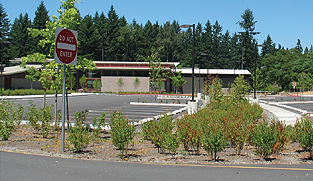|
Subscribe / Renew |
|
|
Contact Us |
|
| ► Subscribe to our Free Weekly Newsletter | |
| home | Welcome, sign in or click here to subscribe. | login |
Construction
| |
 |
August 31, 2006
Rain gardens: effective, natural and cheap
Special to the Journal

Brockway
|

Kinkead
|
Two area schools — one just built, one in the works — have adopted sustainable stormwater management systems that save money, improve aesthetics and behave like a natural forest ecosystem.
The systems, called rain gardens, are site-specific and can collect, treat, filter and slowly release stormwater into the ground more effectively than the traditional “pipe and pond” collection and treatment system. Civil and landscape designers were able to incorporate the rain gardens into areas like parking lots where landscaping is already required.
Building rain gardens into site and landscape designs is becoming more popular and cost effective as sustainable building practices become more commonplace. This is especially true when sustainable strategies are a part of early design.
Rain garden basics
When rain water runs off the site surfaces, gravity directs it to a rain garden or bioretention area.
Native vegetation, plus 3 to 4 inches of bioactive compost and a special soil mix, process the heavy metals, oils and other pollutants from the water. The water passes through the compost to a layer of sandy loam soil that typically sits atop a layer of drain rock.
The plants are an important component of rain gardens because they intercept the rain and provide evapotranspiration. They also protect the soil surface from compaction, while the roots keep the soil open and arable, increasing water retention.
Any excess stormwater that is not held by the rain garden is collected in a perforated underdrain or allowed to infiltrate into the surrounding soils. Overflow is provided for larger storms that exceed the infiltration capacity of the soils.
Unlike detention ponds or biofiltration swales that can become stagnant and muddy, water does not pool in rain gardens. The combined pervious material layers ensure water is immediately drawn away from the surface and absorbed into the ground and plants.

Photo courtesy of Coughlin Porter Benjamin Franklin Elementary in Kirkland has three rain gardens, including two designed to handle runoff from pavement. |
The natural holding capacity of the compost-amended soils helps slow down and cool the runoff while providing significant pollutant removal.
Blending into the scenery
Benjamin Franklin Elementary School, designed by Mahlum Architects and finished in 2005 for the Lake Washington School District, incorporates sustainable design features throughout.
Franklin is in a forested area of Kirkland, so creating a site and landscaping plan to blend with the forested scenery was important.
By carefully modeling the site’s stormwater runoff characteristics, the area needed for bioretention was identified and incorporated into the early design work.
The site features three rain gardens. Two are specifically designed to handle runoff from paved areas used by motor vehicles. The third is designed to handle stormwater runoff from the school’s roof drains.
All use native plants that require minimum maintenance and are adept at standing up to local weather conditions.
Avoiding detention facilities
The rain garden stormwater management system worked so well at Franklin that a similar system will be built at Gray Middle School in Tacoma, also designed by Mahlum.
The school’s 19-acre site is currently occupied by the old Mount Tahoma High School, which will be torn down for construction of the new school.
Working closely with the Tacoma School District, the team established a site design and landscaping plan that uses numerous rain gardens for stormwater management.
Extensive stormwater modeling was necessary to ensure the rain gardens were placed in areas that provided the greatest benefit to the system while ensuring runoff complies with city regulations. The proposed stormwater approach is intended to avoid the need for expensive detention facilities.
Gray has 12 smaller rain gardens designed throughout the campus. They are woven into the fabric of the site, ranging from modest plantings between buildings and within parking lots to more formal landscaping in the school’s plaza. The rain gardens not only manage stormwater runoff, but are integrated into the campus as aesthetic elements and areas for outdoor learning and exploring.
Things to consider
For this approach to stormwater management to be successful, there must be a willingness on all sides to implement a rain garden system, since the method is site-specific and must be custom-designed for each project.
The entire project team — including the owners, design team, municipalities and subcontractors — must work collaboratively and begin early in the design process. It is important to gauge the understanding and comfort level of the regulatory agencies overseeing the project before moving forward with rain gardens as complete stormwater management systems.
The site must also be carefully modeled to optimize the efficiency of the rain gardens and take advantage of the natural drainage basin. Testing the soils will also help determine the best locations for infiltration. Multiple, dispersed rain gardens are preferable to larger centralized systems because a key component of success is to capture and treat the stormwater as close to the source of runoff as is practical.
Communicating with the contractors building the rain gardens is another key. It must be understood that the rain gardens are a stormwater management system, not a standard landscape element.
The designers must make specifications and plan callouts clear and consistent so correct materials are used and appropriately installed. Specifying soils takes substantial knowledge of soil science and a thorough understanding of soil testing, results interpretation and planting requirements.
Rain gardens can be successfully designed into any commercial development. Aside from the obvious benefits of maximizing infiltration and improving water runoff quality, rain gardens are attractive landscaping elements, and, when planted with native vegetation, are extremely low-maintenance and drought tolerant.
Often land that would be otherwise devoted to ornamental code-required landscaping can be transformed into functioning stormwater systems. By planning ahead and working collaboratively, owners and project teams can make rain gardens a reality for any project.
Tim Brockway is a senior project manager for Coughlin Porter Lundeen. Kas Kinkead is a principal at Cascade Design Collaborative.
Other Stories:
- Getting around permitting hurdles takes creativity, teamwork
- Schools losing out as construction costs soar
- Flexible classrooms are a perfect fit
- Careful builders can avoid contract disputes
- Does your school building make the grade?
- Gateway opens up a closed-off campus
- State beefing up health and safety requirements
- Partnerships a high note for school, community


